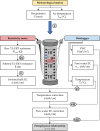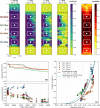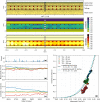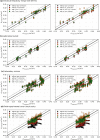A multiscale accuracy assessment of moisture content predictions using time-lapse electrical resistivity tomography in mine tailings
- PMID: 38017002
- PMCID: PMC10684595
- DOI: 10.1038/s41598-023-48100-w
A multiscale accuracy assessment of moisture content predictions using time-lapse electrical resistivity tomography in mine tailings
Abstract
Accurate and large-scale assessment of volumetric water content (VWC) plays a critical role in mining waste monitoring to mitigate potential geotechnical and environmental risks. In recent years, time-lapse electrical resistivity tomography (TL-ERT) has emerged as a promising monitoring approach that can be used in combination with traditional invasive and point-measurements techniques to estimate VWC in mine tailings. Moreover, the bulk electrical conductivity (EC) imaged using TL-ERT can be converted into VWC in the field using petrophysical relationships calibrated in the laboratory. This study is the first to assess the scale effect on the accuracy of ERT-predicted VWC in tailings. Simultaneous and co-located monitoring of bulk EC and VWC are carried out in tailings at five different scales, in the laboratory and in the field. The hydrogeophysical datasets are used to calibrate a petrophysical model used to predict VWC from TL-ERT data. Overall, the accuracy of ERT-predicted VWC is [Formula: see text], and the petrophysical models determined at sample-scale in the laboratory remain valid at larger scales. Notably, the impact of temperature and pore water EC evolution plays a major role in VWC predictions at the field scale (tenfold reduction of accuracy) and, therefore, must be properly taken into account during the TL-ERT data processing using complementary hydrogeological sensors. Based on these results, we suggest that future studies using TL-ERT to predict VWC in mine tailings could use sample-scale laboratory apparatus similar to the electrical resistivity Tempe cell presented here to calibrate petrophysical models and carefully upscale them to field applications.
© 2023. The Author(s).
Conflict of interest statement
The authors declare no competing interests.
Figures















References
-
- Robinson DA, et al. Advancing process-based watershed hydrological research using near-surface geophysics: A vision for, and review of, electrical and magnetic geophysical methods. Hydrol. Process. Int. J. 2008;22(18):3604–3635. doi: 10.1002/hyp.6963. - DOI
-
- Beff L, et al. Three-dimensional monitoring of soil water content in a maize field using Electrical Resistivity Tomography. Hydrol. Earth Syst. Sci. 2013;17(2):595–609. doi: 10.5194/hess-17-595-2013. - DOI
-
- Vereecken, H. et al. On the value of soil moisture measurements in vadose zone hydrology: A review. In: Water resources research, 44(4), (2008). ISSN: 1944-7973.
-
- Brocca L, et al. Soil moisture estimation through ASCAT and AMSR-E sensors: An intercomparison and validation study across Europe. Remote Sens. Environ. 2011;115(12):3390–3408. doi: 10.1016/j.rse.2011.08.003. - DOI
-
- Dorigo W, et al. ESA CCI soil moisture for improved earth system understanding: State-of-the art and future directions. Remote Sens. Environ. 2017;203:185–215. doi: 10.1016/j.rse.2017.07.001. - DOI
Grants and funding
- Collaborative Research and Development/Natural Sciences and Engineering Research Council of Canada
- Collaborative Research and Development/Natural Sciences and Engineering Research Council of Canada
- Collaborative Research and Development/Natural Sciences and Engineering Research Council of Canada
- Collaborative Research and Development/Natural Sciences and Engineering Research Council of Canada
- Collaborative Research and Development/Natural Sciences and Engineering Research Council of Canada
- Collaborative Research and Development/Natural Sciences and Engineering Research Council of Canada
- Merit scholarship program for foreign students/Fonds Québécois de la Recherche sur la Nature et les Technologies
- Bourse des pionniers de la géophysique québécoise/Canadian Exploration Geophysical Society
- SEG/WesternGeco/Henry Salvatori Memorial Scholarship/Society of Exploration Geophysicists
- Jean-Descarreaux merit scholarship/Fondation de l'Université du Québec en Abitibi-Témiscamingue
LinkOut - more resources
Full Text Sources

